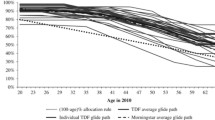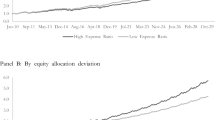Abstract
We investigate the effectiveness of target date mutual funds (TDMF) performance relative to naive self-directed target date portfolios and identify which variables are related to positive performance. Overall, we find target date mutual funds do not outperform naive strategies but find several characteristics which are associated with positive Sharpe and Treynor ratio performance. When comparing TDMF to naive strategies, we find alpha, volatility, assets, dividend yield and turnover are positive and significant coefficients, while beta is negative and significant. Variables such as Morningstar rating and expense ratio are not significant, and puzzling given fees on TDMFs are typically higher than other funds. Investors are choice architects will be interested in the results as both are in some ways responsible for making good retirement investment choices. The paper also identifies the difficulty in using tools developed for all equity mutual funds to measure the unique aspects of TDMFs, specifically the glide path.


Similar content being viewed by others
References
Arnott, R., K. Sherrerd, and L. Wu. 2013. The Glidepath illusion and potential solutions. The Journal of Retirement 1 (2): 13–28.
Bhattacharya, U., A. Hackethal, S. Kaesler, B. Loos, and S. Meyer. 2012. Is unbiased financial advice to retail investors sufficient? Answers from a large field study. Review of Financial Studies 25 (4): 975–1032.
Benartzi, S., and R.H. Thaler. 1999. Risk aversion or myopia? Choices in repeated gambles and retirement investments. Management Science 45 (3): 364–381.
Benartzi, S., and R.H. Thaler. 2002. How much is investor autonomy worth? The Journal of Finance 57 (4): 1593–1616.
Benartzi, S., and R. Thaler. 2007. Heuristics and biases in retirement savings behavior. The Journal of Economic Perspectives 21 (3): 81–104.
Bodie, Z. 2011. The long-run risk of stock market investing: Is equity investing hazardous to your client’s wealth? In CFA institute conference.
Bodie, Z. 2015. Thoughts of the future: Life-cycle investing in theory and practice. Financial Analysts Journal 71 (1): 43–48.
Bodie, Z., R. Fullmer, and J. Treussard. 2010. Unsafe at any speed? The designed-in risk and target date glide paths. Journal of Financial Planning 23 (3): 42–48.
Bodie, Z., R. Fullmer, and J. Treussard. 2007. Making investment choices as simple as possible, but not simpler. Financial Analysis Journal 63 (3): 42–47.
Choi, J., D. Laibson, B. Madrian, and A. Metrick. 2003. Optimal defaults. The American Economic Review 93 (2): 180–185.
Cohen, L. 2009. Loyalty-based portfolio choice. Review of Financial Studies 22 (3): 1213–1245.
Hsu, J., J. Treussard, V. Viswanathan, and L. Wu. 2015. Two determinants of lifecycle investment success. The Journal of Retirement 2 (4): 14–21.
Huberman, G., and W. Jiang. 2006. Offering choice in 401(k) plans: Equity exposure and number of funds. The Journal of Finance LXI (2): 763–801.
Huberman, G., and P. Sengmueller. 2004. Performance and employer stock in 401(k) plans. Review of Finance 8: 403–443.
Markowitz, H. 1952. Portfolio selection. The Journal of Finance 7 (1): 77–91.
Madrian, B., and D. Shea. 2001. The power of suggestion: Inertia in 401(k) participation and savings behavior. The Quarterly Journal of Economics CXVI (4): 1149–1187.
McKenzie, C., and M. Liersch. 2006. Recommendations implicit in policy defaults. Psychological Science 17 (5): 414–420.
Mitchell, O., & Utkus, S. 2012. Target-date funds in 401(k) retirement plans. NBER Working Paper Series.
Pfau, W. 2010 Lifecycle funds and wealth accumulation for retirement: Evidence for a more conservative asset allocation as retirement approaches. Grips policy research center discussion paper 10–10.
Poterba, J., Rauh, J., Venti, S., & Wise, D. 2006. Lifecycle asset allocation strategies and the distribution of 401(k) retirement wealth. NBER working paper.
Sexauer, S., M. Peskin, and D. Cassidy. 2012. Making retirement income last a lifetime. Financial Analysts Journal 68 (1): 78–84.
Tang, N., and Y.T. Lin. 2015. The efficiency of target date funds. Journal of Asset Management 16 (2): 131–148.
Treussard, J. 2007. The non-monotonicity of value-at-risk and the validity of risk measures over different horizons. The ICFAI Journal of Financial Risk Management 4 (1): 7–18.
Thorton, N. 2016. Target-date fund assets post another all-time high in Q1” http://www.benefitspro.com/2016/06/27/target-date-fund-assets-post-another-all-time-high.
Acknowledgements
Yi gratefully acknowledges research support from the McCoy College Development Foundation at Texas State University.
Author information
Authors and Affiliations
Corresponding author
Appendix 1: data and sample construction
Appendix 1: data and sample construction
We search target date mutual funds from Bloomberg and other sources and initially found 234 TDMFs. After deleting missing equity weights, return distributions, and fund identifiers, we are left with 171 TDMFs. After including target dates of 2035, 2040, 2045 and 2050 only, we are left with 144 TDMFs after dropping 24 TDMFs with 2055 target date and 3 TDMFs with 2060 target date.
In this study, we create two simulated portfolios using SPY and TLT. The first simulated portfolio is created by assuming 60% of capital invested on SPY and the rest of capital invested on TLT. Each TDMF is matched by this 60:40 simulated portfolio. The second simulated portfolio is created by assuming we invest on SPY by simulating each TDMF’s specific equity position and invest the rest of capital on TLT.
Note that TLT starts trading on July 29, 2002. Therefore, those TDMFs existed before TLT’s first trading date enter our sample on July 29, 2002, to be consistent with dates covered by the simulated portfolios. In addition, some TDMF which were introduced more recently into the market enter our sample after July 29, 2002, and each TDMF within the same target data may have different starting dates. As a result, there are 144 TDMF-simulated portfolio observations.
Rights and permissions
About this article
Cite this article
Johnson, W.F., Yi, HC. Do target date mutual funds meet their targets?. J Asset Manag 18, 566–579 (2017). https://doi.org/10.1057/s41260-017-0054-7
Revised:
Published:
Issue Date:
DOI: https://doi.org/10.1057/s41260-017-0054-7




